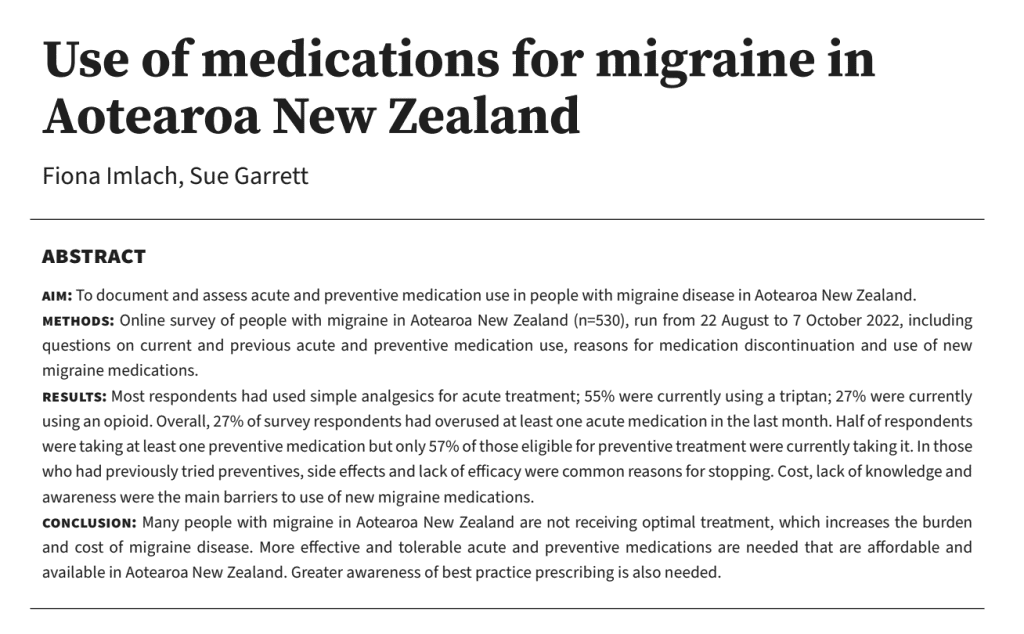Press release
Many people with migraine in New Zealand are not receiving best-practice management, according to research published today in the New Zealand Medical Journal using results from a survey of 530 people with migraine run by Migraine Foundation Aotearoa New Zealand.
The lack of best-practice management occurred with both treating and preventing migraine attacks.
“Prompt treatment of attacks with non-steroidal anti-inflammatory drugs (NSAIDs) and migraine-specific drugs (triptans) is the bedrock of migraine attack management,” says Dr Fiona Imlach, senior research fellow at the University of Otago’s Department of Public Health and co-founder of the Migraine Foundation.
“However, if triptans are taken for more than 9 days a month or NSAIDs for more than 14 days a month for three months in a row, people are at risk of developing a new chronic headache, often called ‘medication overuse headache’. Around a quarter of survey respondents had taken at least one migraine attack treatment more often than the recommended limit in the last month, putting them at risk of developing this headache.”
Experts also recommend against regularly treating migraine attacks with opioids, which include codeine and tramadol, because they have significant side effects, are not as effective as migraine-specific medication, and can be harmful.
“It was disappointing to find that around a quarter of survey respondents were currently using opioids and nearly one in five were taking opioids more frequently than recommended,” Dr Imlach says.
“That’s a big number when it’s well recognised that opioids cause medication overuse headache and are addictive, so they can be difficult to stop using – but patients have to stop them if they develop medication overuse headache. These are prescription or pharmacy only medicines and the health professionals who are prescribing or selling them have a responsibility to warn people with migraine of the risks associated with them, particularly the risk of medication overuse headache. Not doing this is a breach of their duty to do no harm.”
The other area of suboptimal management was in preventive treatment to reduce the number and severity of attacks for people who have frequent and disabling migraine attacks.
“Although three quarters of survey respondents were eligible for preventive medication, only 57% of these people were currently taking one,” says Dr Imlach.
“We also found that over a quarter (28%) of respondents with chronic migraine were not taking a preventive. These are people who experience headache on 15 days or more a month, and obviously need an intervention, but for whatever reason they weren’t getting one.”
However, the main issue with preventive medication was finding something that worked. “Traditional oral migraine preventives include antidepressants, beta blockers, antiepileptics and antihypertensive drugs,” says Dr Imlach.
“None of these drugs were developed to treat migraine but were co-incidentally found to have some use in migraine treatment. This means they have side effects and don’t always work very well, or they lose their effectiveness over time. We see this in the survey from finding that many more people had previously used preventives than were currently using them.
“For example, only 8% of respondents were currently taking an antiepileptic for migraine prevention but 30% had previously taken one; 28% were currently taking an antidepressant for migraine but 36% had previously taken one. People stopped taking preventive medications mostly because of side effects or lack of effectiveness.”
One 63-year-old survey respondent explains, “I have tried many medications and am still trying to find one that works – it’s all trial and error, and it’s my body that is being beaten around while trying to find the one or the combination of medicines that work for me. So far nothing works without bad side effects.”
“The problem here is not that people aren’t trying to manage their migraine disease,” Dr Imlach says.
“In our survey, people with chronic migraine had tried an average of 4 preventive medications, and 12% of all survey respondents who tried preventive medications had tried 7 or more. This is a problem of the traditional medications not being targeted for migraine disease. However there is hope. In the last few years, we have seen a range of new medications come to market that were developed specifically for migraine, that are effective for many people and do not have the side effects of the older medications. These are now recommended as first-line treatments in the US and Europe.”
Three of these new medications (galcanezumab, erenumab and atogepant) have recently been placed on Pharmac’s Options for Investment list, which means they have been prioritised for funding. Whether these will be included in the list of medicines that will be funded by the Government’s $604 million boost to Pharmac’s budget over the next four years is not yet unknown.
“This research highlights a range of issues,” Dr Imlach says.
“There is a clear need for more and better migraine treatments, to both manage and prevent migraine attacks. New treatments have been developed but most of them are not available in New Zealand and none of them are funded yet. We need better awareness and education for health professionals and people with migraine about how to avoid medication overuse headache, to manage migraine according to best practice and not cause harm. All of these things are needed to give people with migraine in New Zealand a better quality of life and ability to live productive and engaged lives.”
Notes to editors:
The research paper ‘Use of medications for migraine in Aotearoa New Zealand’ is published in the New Zealand Medical Journal.
For more information please contact:
Dr Fiona Imlach
Co-founder Migraine Foundation Aotearoa New Zealand
fiona@migrainefoundation.org.nz
You can read the full article by subscribing – subscription is free


